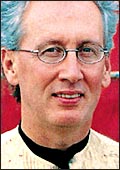|
John
Ustas, CEO of Hindustan Coca-Cola Beverages, the bottling arm
of cola major Coca- Cola India, has doubled his sales force from
1,000 a year ago to 2,000 now. This, he says, is in anticipation
of the fast growth he foresees in the coming year. His counterpart
in the concentrates business, Atul Singh, CEO of Coca-Cola India,
claims that growth is already back in the business-Coke's volumes
grew 4 per cent in India during the quarter ended September 30,
2006, ending a six-quarter declining streak, according to the
Securities & Exchange Commission filing by the parent company-and
asserts that "colas are the way forward for the company".
Adds Ustas: "Our bottling operations have turned cash-positive
after a long time."
Sure, the second round of the pesticides
controversy in August revived fading public interest in the alleged
harmful ingredients in carbonated soft drinks (CSD) but this doesn't
rattle Singh and Ustas any more. Singh, in fact, sees huge growth
opportunities in the cola segment. "We strongly feel that
there is genuine demand for safe, rehydrating, refreshing and
affordable drinks like colas in India," he says, adding that
his confidence is based on the general economic and demographic
scenario in the country that favours a sentiment for "indulgences".
 |
| Cola factor: One-size-fits-all strategy
does not work |
The numbers favour his argument-the penetration
of CSD in India is only around 8-10 per cent compared to almost
100 per cent in the US and 70-80 per cent in Europe. "Even
Pakistan has a per capita consumption of 24 bottles a year compared
to 9-10 here," he adds. But under-penetration can only be
a pointer to potential. And, the same argument had been put forth
about rural India, but that proved to be a chimera. "The
magnificent growth in volumes in the initial months of the Rs
5 strategy proves that there is unfulfilled demand in the rural
markets. We withdrew because we introduced that price point for
the entire market, which, obviously, was unsustainable,"
he says. For Coca-Cola, the biggest learning over the last year
has been that the one-size-fits-all strategy does not work in
India. "Each market will have to have a distinct product
and pricing strategy. We call it brand, pack, price and channel
strategy," says Singh.
Greater reach equals higher sales?
Ustas, meanwhile, is busy fixing the ground
for him. "The biggest challenge in India is the lack of infrastructure-bad
or no roads, irregular or no supply of electricity and the inability
of retailers to invest in refrigerators, to name just three,"
he says. The company is investing about $250 million (Rs 1,125crore)
to firm up its distribution channel in these areas. "We have
around 850,000 retailers (which compares well with even some top
FMCG companies). My objective is to reach out to the entire 15
million FMCG retailer base in India as soon as possible,"
he adds.
 |
So far, we have around
8,50,000 retailers which is quite significant even when compared
to some of the top FMCG companies. My objective is to reach
out to the entire 15 million FMCG retailer base in India as
soon as possible
John Ustas
CEO, Hindustan Coca-Cola Beverages |
But what about reports that consumers are
increasingly turning away from carbonated drinks towards healthier
options? The market for juices is growing faster than colas. According
to estimates, the former has grown 20-22 per cent over the last
two years, against 3-4 per cent this year for colas (and no growth
last year). This is in line with global trends. PepsiCo clocked
$32 billion (Rs 1,44,000 crore) in global revenues last year against
Coke's $23 billion (Rs 1,03,500 crore) thanks to its fast-growing
non-carbonated business. And there's no reason why India should
buck the global trend. Says Shruti Basavaraj, an analyst with
The Motley Fool, an investment and financial services company
based in Virginia, us, that closely tracks Coca-Cola and Pepsi:
"Pepsi's guidance for 11 per cent growth is higher than Coca-Cola's
goal of 6 per cent. This can be explained from the fact that Coca-Cola
gets around 80 per cent of its sales from its CSD portfolio whereas
Pepsi gets around 75 per cent of its revenues from snacks and
non-carbonated drinks, which is growing faster than the CSD segment."
According to reports, Coca-Cola, is diversifying its portfolio
in the us. Mary Minnick, Head, Marketing, Strategy and Innovation
in Atlanta, has launched 1,000 new variants of its various brands,
including colas, energy and sports drinks (Powerade, Aquarius,
Samurai, TaB Energy, Full Throttle), water (Dasani, Siel, BonAqua)
and juices (Cappy, Minute Maid) in the last one year. She is obviously
banking on Coca-Cola's strong brand equity to pull it off. Says
Tom Blackett, Deputy Chairman, Interbrand, a renowned global brand
consultancy firm: "Coca-Cola has remained the world's top
brand in our surveys year after year (Pepsi trails at #22)."
According to Blackett, Coke's brand extensions in new categories
can be just as successful as the mother brand.
| Churning At The Top |
 |
| Sanjeev Gupta |
 |
| Alex Von Behr |
 |
| Donald Short |
Coca-Cola has had an extremely
unstable top management team since it set up shop in India
in 1993. In a span of 13 years, the company has seen half-a-dozen
CEOs flit in and out-Jaydev Raja, Rick Nicholsan, Don Short,
Alex Von Behr, Sanjeev Gupta and incumbent Atul Singh. Its
rival Pepsi, on the other hand, has had only two chiefs, Suman
Sinha and the man who succeeded him in 2001, Rajeev Bakshi.
(Pepsi had entered India in 1988 with a three-way joint venture-the
other partners were Punjab Agro Industrial Corporation and
Voltas India-which was headed by Ramesh Vangal). It was announced
at the time of going to press that Sanjeev Chadha would take
over from Bakshi, who is being transferred to Hong Kong. "It
is this churn at the top management level that has really
hurt Coca-Cola in India," says a former Coca-Cola executive.
Interestingly, all this while its head office in Atlanta
was also seeing a similar churn. Following the death of
its legendary CEO Roberto C. Goizueta in 1997, the company
has had three CEOs; Goizeuta had run the company for 17
years. Singh admits that such churning can take a toll on
the growth of and the sentiment within the company. "We
have realised that the Indian leadership team has to stay
on longer to steer the company towards its long-term growth
plans. I do plan to stay around till I put the company firmly
back on the growth track," he says.
|
Expanding Portfolio
Singh says the small size of the Indian market
has stopped the company from introducing many new products. Still,
he has soft-launched premium water brand Schweppes (a brand that
Coke now sells in markets outside the us), energy drink Powerade,
fruit drink Cappy and some other premium products in some Indian
markets. "The juice and health drinks market has yet to take
off," he argues. While the size of the cola market is estimated
to be around 400-450 million cases; the juice market is less than
a third of this. In value terms, the CSD market is worth Rs 5,500-6,000
crore (Coke's share is estimated to be Rs 3,000-3,400 crore; Pepsi
accounts for the rest); the branded juices market is valued at
Rs 400-450 crore.
Coca Cola India gets over 85 per cent of
its revenues from carbonated drinks; and the scene is not very
different at Pepsi. Says PepsiCo's Executive Marketing Director,
Punita Lal: "Carbonated drinks contribute 80 per cent to
Pepsico India's total sales; juices, water and other non-carbonated
drinks make up the rest." Pepsi's overall Indian revenue
numbers seem less skewed because its snacks business, clubbed
under Pepsi Foods, contributes another Rs 1,000 crore. But Coca-Cola
India has no plans of entering the snacks market. "We are
a beverages company and will remain that way," says Singh.
Though, he declines to divulge future plans, there are indications
that Coca-Cola will soon launch Minute Maid juices and some other
energy and sports drinks in India next year. It is also planning
to add new variants to its tea and coffee portfolios. Clearly,
Coca-Cola is diversifying its portfolio in India in its search
for growth.
But colas, which are facing massive consumer
resistance all over the world-including in the US and Europe-will
remain its bread, butter and (it is hoping) jam over the next
five years, at least. And that's something quite reassuring for
Singh because his CSD portfolio comes across as stronger than
Pepsi's. Brand Pepsi is bigger than Coke in India, but Coke plus
Thums Up are ahead of Pepsi. In the cloudy lemon segment, Pepsi
has consistently failed to topple Coca-Cola's well-entrenched
Limca. Similarly, in the mango and orange drinks categories, both
Maaza and Fanta (owned by Coca-Cola) have larger market shares
than Slice and Mirinda. PepsiCo, however, disputes these claims.
But then, it is a reality that despite its
spectacular march over Coke in the us in overall business, Pepsi
has never been able to sell more cola than Coke in any of the
markets it is present in. And if Atul Singh, a Coke veteran with
over a decade's experience in markets like the US, Europe and
China, has decided to confine his battle mainly to carbonated
drinks, it's because he is backing himself to win it.
|










